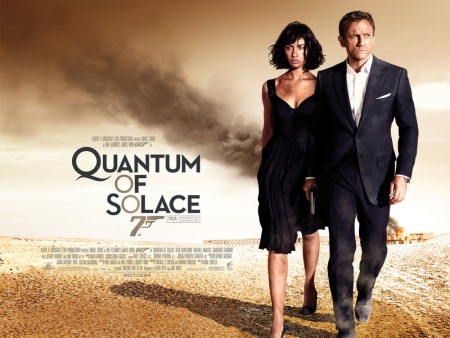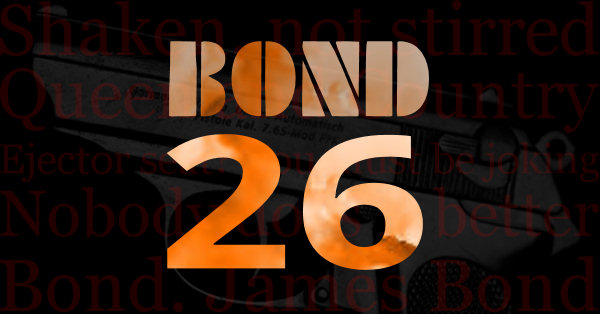Quantum of Solace, the 22nd of EON Productions’ James Bond adventures, was released in late 2008. Hot on the heels of Casino Royale, it broke opening records in the UK and went on to $168 million in the US, which made it the second highest grossing in the series, a million more past the prior entry. However, adjusting for inflation, that puts it at #13 in the series, and it also is one of the most critically divisive of the lot.

One of the major criticisms of the film is the editing, pacing, and camera work. This complaint starts right off the bat as the film opens with Bond in medias res of his escape from Mr. White’s villa. After the opening logos (with no gun barrel sequence – I’ll get to that later), the camera zooms across the water towards the chase, intercut with some artfully done shots of Bond and his pursuers moments before they spring into action. Once they do engage, one scant minute into the film, the images fly fast and furious as cars collide and bullets fly, reminiscent of the work of early 007 editor Peter Hunt.
I can see how the abruptness would be jarring, especially depending on how close one sits to the screen, but the action explodes with such a ferocity, the audio so loud, that the viewer is immediately thrown into this world feet first, and without a Union Jack adorned parachute, no less! After the initial flurry of images, the cutting does smooth out some as Bond continues his tear through the Italian countryside, eventually ridding himself of his would be dispatchers. As he pulls into MI6’s underground lair in Sienna, a beautiful looking title card appears and the film takes its first breath. The camera holds on 007 as he drives into safety, stepping out to retrieve Mr. White from the boot of his Aston Martin.
The film does this more often than one realizes. After Mitchell is dispatched we have a small moment of contemplation by Bond as he arrives back at the empty MI6 hideout and one by M as the scene transitions to London. In fact, most of the transitional scenes where we are introduced to a new city take a moment to breathe, along with a specific font announcing that location.
When Bond is attacked in the hotel room in Haiti, the action is ramped up again, calling back to the fights in From Russia With Love and On Her Majesty’s Secret Service in their brutality and editing. What’s interesting in this scene is that when we take the breather moment, it focuses on the consequences of 007’s actions, and the camera holds on the would be assassin, his dead stare affixed to oblivion. Then, it’s back to business as we get some rapid cuts as Bond mends his appearance and heads to the street.
My favorite of these breathers follows the boat chase in Haiti. Now the boat chase itself may seem a tad slower compared to the opening car scene, but the action is no less rapid. In fact, even pausing the film, I can’t figure out how Bond throwing the anchor into his attackers’ boat causes them to flip whilst Bond and Camille get away.
Regardless, much of the audio drops out and we hold on Bond steering the boat to port with the score playing notes that are also used in Shirley Bassey’s “No Good About Goodbye”, which is a terrific song off her album “The Performance” if you haven’t already heard it. Bond exits, handing off an unconscious Camille to a stranger, saying she’s sea sick. Craig’s delivery of the one liner is great and a very Bondian moment.
For me, one of the perfect sequences in the film is the opera. Quantum is having a clandestine meeting amidst a performance of “Tosca” and so many brilliant elements come together. The set is grand, the pacing is precise, and the subtleties of the performance all combine with a great piece of music to build tension and drama.
After Bond interrupts Quantum’s conversation, he unknowingly walks past an isle where his nemesis, Mr. White, sits in plain sight, coolly holding his ground. The opera swells as we see Bond and Greene meet in a standoff, reminiscent of a Western. Greene’s eyes seethe and Bond throws him a glance as he makes his exit, Greene’s men in pursuit. Again, the pacing becomes rapid as we intercut between the chase and the opera on stage, but combined with the muted sound affects, becomes a very effective piece of cinema. You feel the calamity as Bond makes his escape.
We slow down again as we establish Bond’s visit to Talamone. Here we are reintroduced to Mathis and it is very welcome as it clears him of the accusations Le Chiffre made against him in Casino Royale. It’s an important relationship for the movie. Not only is Giancarlo Giannini charming in the role, but also so much of 007’s character is revealed thru him.
We see that Bond is man enough to admit mistakes, not too proud to ask for help, and that he still feels deeply for Vesper, despite her betrayal. One of the most telling character moments for Bond comes as he holds the dying Mathis in his arms. Not only is it shocking to fans of the literary 007 as Mathis is still alive in the novels, but upon his passing in the film, Bond dumps his body callously in the trash, taking his money as well. Camille asks, “Is that how you treat your friends?” Combined with the score, it is a haunting scene.
Supporting Cast
Most of the supporting cast has their character arcs, despite different lengths of screen time. Camille makes for a beautiful, but atypical Bond Girl, inasmuch as she and 007 never go to bed. Bond has teamed with other agents before, be it Pam Bouvier, Wai Lin, Holly Goodhead, or Jinx, but Camille’s parallel mission of revenge brings something new to the mix, providing a mirror to Bond.
There is a moment at the end of the film where Bond and Camille are trapped by fire and are about to seemingly die. Camille is frozen by her childhood fear and I got the impression Bond was about to shoot her to spare her a worse fate until he sees the way out of their predicament. Whilst Bond comes to her rescue in this case, Camille is not a simple damsel in distress, tho’ Bond initially mistakes her for one earlier in the picture when he tries to rescue her from Medrano’s boat. In fact, she gets her revenge without 007’s intervention. She even points out Bond’s internal struggle at the end of the film and is strong and wise enough to realize only he can free himself from his demons.
Agent Fields, or Strawberry Fields, as she is revealed in the end credits, isn’t as fortunate. She winds up being the sacrificial lamb, succumbing to Bond’s charms, and her assistance gets her killed in a manner calling back to Jill Masterson from Goldfinger. Her method of dispatch is a red herring set up by the villains. I am curious why the decision was made to not reveal her name in the movie proper. Do the producers think modern audiences will no longer accept the Bond Girl style of names from yore?
Felix Leiter also makes a welcome return, in more ways than one. This marks the second time in the history of the series that an actor has portrayed him twice. I would have wished to see him interact more with 007, but for his short screen time, he faces his own moral decision-to aid his friend or back up his superior. In the end, the right man keeps his job and I hope we see Jeffrey Wright return. The continuity he brings aids the film and does help link this film with the one prior.
Quantum
The threat in this movie is more covert than in ones past, much like the Quantum organization itself. Controlling water for a third world country may not seem as sexy as holding the world ransom with nuclear warheads or irradiating the gold supply, and it is masked under the false pretense of oil, but director Marc Forster conveys its importance when Bond and Camille walk amongst the thirsty people of La Paz. This is yet another example of how the pace slows down in the film for the audience to catch their breath after the plane chase.
Forster brings a great visual flair to the film overall. His shot composition is great and he gives each location its own unique feel, which is aided by the aforementioned title cards and their respective fonts. His desert sequences give off the feeling of barren heat. Having lived in a desert region for most of my life, it’s not my favorite locale, but Forster brings polish to his visuals, be it Austria, London, Italy, Panama, Mexico, or Chile.
Music
David Arnold continues his strong work with the film’s score. He continues to veer away from the electronica sound that he would imbue Brosnan’s films with to give Craig’s its own melodic identity. We hear the reprise of Vesper’s theme from Casino Royale to strengthen the emotional link with the audience and of course, the familiar chords of the James Bond Theme. One of Arnold’s strongest pieces this time out is “Night at the Opera”. I feel you could plug this song into any of the scores Barry composed and it would fit right in. Like the title cards, Arnold also adds regional flavour to the music, as heard in “Bond in Haiti”, “Bolivian Taxi Ride”, and “Talamone”.
“Another Way To Die”, the film’s title song, not only is as controversial as the film’s editing, but also bears the distinction of being the first duet in the series. Love it or hate it, the single reached #9 in the UK, won Best Song at the Satellite Awards, and was even nominated for a Grammy.
The horns give it the requisite Bond sound compared to another controversial theme song, “Die Another Day”, especially when laid over the main titles. Featuring sweeping dunes, Daniel Craig, and the typical guns and silhouetted women, it also calls back to the opening of Dr. No with the travelling dots. MK12 does a fine job capturing all the elements that Maurice Bender and Danny Kleinman have familiarized viewers with over the last 50 years.
Gun Barrel Sequence
Another controversial choice was the gun barrel sequence placement. As a traditionalist, I would always want to see the Bond pictures open with it. However, I’ll allow the artistic licence that after this film the 007 we all know and love is fully formed as a character. Having the gun barrel at the end signifies he is ready to begin. The problem with this argument is director Sam Mendes repeats the placement in Skyfall, only in this case, the status quo that began with Connery is now set. This repetition damages its use in Quantum of Solace, as nice as it is to think that the Skyfall gun barrel marks the beginning of the next 50 years of cinematic Bond.
As fast paced and rapidly edited as people critique Quantum of Solace for being, and make no mistake, it is a tight action film; there are some great character beats and themes. It’s not simply Casino Royale, part II. It is a complex world where goodness and corruption can lie within friends and allies, making it unclear which side will come out on top. We see this in Leiter and Beam, with M and the Foreign Secretary, in the Bolivian government, and within Bond’s own self. We see a Bond still so grief stricken, he imbibes six of the martinis he named after his lost love. The camera moves at a blinding pace sometimes to demonstrate how Bond is wantonly cutting a path of destruction trying to come to terms and find his own quantum of solace.
There are times where it seems 007 will do anything to get his revenge. When we finally reach the apex of his manhunt, Bond has a deadly, quiet calm. His voice is hushed and restrained as he confronts Yusef. 007 makes his peace and is ready to continue defending Queen and Country.
Quantum of Solace is a unique Bond film in several regards that deserves another look if it wasn’t one’s cup of tea on first viewing. There are several reasons I feel it is a worthy entry in the series, but one thing I won’t defend is the jump from the DC3. I appreciate how they attempted to make it look real, but it pales in comparison to the sky diving in Moonraker!
Javier E. Trujillo is a communications medic and lifelong fan of all things Bond. He can be reached on Twitter at @JaviTru











September 2nd, 2014 at 17:02
Sorry, but for me still is the worst Bond ever.
September 2nd, 2014 at 20:25
Is that all you can say to the article?
Justify your statement.
September 3rd, 2014 at 00:31
I disagree. After the “bestest” Bond ever (Casino Royale), Quantum of Solace felt a little short on creativity; anyway, I’m not sure you could equal Casino Royale for its way of reinventing the character. But is wasn’t nearly as bad as Skyfall, where credibility went down the sinkhole. C’mon, you can’t get shot with a 9 mm and keep on fighting, and on top of that to get shot by a 5.56 mm rifle, fall some 60 meters in the water and keep on living? He is Bond, James Bond, not a Terminator android.
September 12th, 2014 at 18:45
Fine article! Thank you. “Quantum” is valid as a Bond film, “Another Way to Die” really says it well, but it is my least favorite of the films because, in the order of worst first, then:
– the colors at the great climax scene are so sere! The flames grate rather than enflame. Something is not right….
– I was born and raised with Sci-tech and my son’s first degree was in film and I work in arts, but they push the line too far with the special effects, for easy power thrills and actually UNDO the power of a Bond Story – difficult to respect.
– The women are NOT the Bondgirl-icon adventuregirls but victims in their psychologies – “M”, Camille, Strawberry…all are too vulnerable due to age, abuse and naivete to be Bond Girls. That element deflates the film I think. And it makes our hero the thug, indeed with Strawberry – not Oxford, tut, tut!
There is more, but I will stop with agreeing with you about the Gunbarrel Sequence. Placing it at the end is an insult – “we must humor the old fogies along for a bit, before we get rid of it altogether…” it seems to say. If there is a petition going to get it placed at the start, once again – I will sign.
I still watch my “Quantum” video from time to time – but….
Thanks again
elle
October 9th, 2014 at 14:30
It is definitely better than people give it credit for.
It may even feature Daniel Craig´s best performance as James Bond- slicker than Casino, not as needlessly cerebral as Skyfall.
But it does feel too short and they tried to cram in too many ideas for such a short film- Bond´s broken heart, difficult relationship with M, inner rediscovery, distrust of the CIA etc.
It feels like ´X-Men: The Last Stand´- the potential to be a brilliant film, but the end result was too shoddily put together to allow the film to breathe as it should have.
But thank you for defending it. It really is not the worst Bond film. Hell, it´s better than the majority of Pierce Brosnan´s films.
April 30th, 2020 at 22:30
It is by no means the worst bond film but it had big shoes to fill after Casino Royale. CR has the benefit of drawing from the fantastic story of the first and original novel and stuck, whilst refreshing matters to the present, pretty much to the plot. A Quantum of Solace was always going to struggle against this. For me Skyfall was far worse, shoot me if you don’t agree, but it’s story was even less tangible. And then we get to… I will leave it there.
February 26th, 2021 at 20:32
I love QoS. I’ve watched it many times. To be honest, I fear that those individuals that hate this movie have likely seen it once or twice. I’d bet they haven’t seen it as often as I have. Having said that, the movie isn’t perfect. It does have some of the best “sneaky Bond” moments of any Bond film. The style in this film may be the best out of any Bond film. The story is as tight as the editing. Sure there is a man that is sweeping the ground whilst the broom never touches the ground or a couple of people walking through the hotel and you can clearly see they just started walking. But it doesn’t detract from the film. This is the complete opposite of the light-hearted Roger Moore Bond films. I love those too. If I were a betting man I’d bet that as time passes this film will edge up to an OHMSS level of of respect. If it does, then I’d truly have my own Quantum of Solace, ( a measure of comfort ).
March 13th, 2022 at 22:08
Thanks for the careful review. I didn’t care for it at first but keep re-watching it. The hotel fight when he reaches down to check the man’s pulse was quite moving. The escape from M after discovering SF dead was very good. The fight scene with the ropes and glass is a remake of a Laurel & Hardy scene played for comedy. Opera scene showing him break off the toilet door handle- so preposterous it killed it for me. Sex is a major theme in Fleming, realism, maturity masculinity. Craig/Bond, in my opinion is an unwelcome reversal. CR is marred by Bond squealing like a girl when he discovers Vesper has tailored his clothing. There is no chemistry between Bond and Vesper. No love in QOS. Skyfall is very impressionistic, surreal even. All sympbols, villain with mommy issues makes it Craig’s best. NTDD, a ridiculous film, the title is a clue and the doll doodu, a slang term for shit. Bond morphes into a woman, the females take his name the various women are martial arts experts etc. He is superfluous, perhaps appropriate for the times.
August 23rd, 2022 at 15:23
It’s a grow-er not a show-er this one. It’s way better than most give it credit for. I hated it on first viewing but grew to like it a lot over repeated viewings.
This great piece from the Film Speak team explains. Yes i hate the close in quick cuts. Yes the story suffers coz of the writers strike but there’s plenty to recommend this one. Craig is great here, the Sienna and Austria scenes and of course it’s Arnold’s amazing score holding it all together.
https://youtu.be/iAKX3gBaLAY